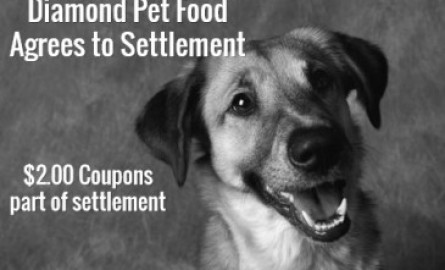This blogsite sponsored by Build A Better Dog
Years ago I worked for a major feed company and my sales manager, Lester Blackwelder, was a great guy who loved to tell stories and joke around. He told me he ran into a customer who raised rabbits and the man confronted him and yelled, "Damn you and your company, that feed you sold me killed all my rabbits."
Lester answered him saying, Don't worry, we'll get you some more rabbit feed."
I think maybe Diamond Pet Food Company heard the story.
Coupons as Diamond Pet Food Settlement?
April 4, 2014 3 Comments
No kidding. Diamond Pet Food agrees to a class action settlement from their 2012 Salmonella recall providing $2 coupons. (Some) Class members shall receive one or more coupons.
Even though Diamond Pet Food “deny any wrongdoing” in the 2012 Salmonella recall which resulted in Chicken Soup for the Pet Lover’s Soul, Country Value, Diamond, Diamond Naturals, Premium Edge, Professional, 4Health, Taste of the Wild, Apex, Kirkland Signature and Canidae being pulled from store shelves for possible contamination – the pet food manufacturer has agreed to a settlement with pet owners.
From LegalNewsLine.com…
“There are three subclasses of class members. Subclass I includes consumers who purchased certain pet food products in 2011 and 2012.”“The defendants will create a settlement fund limited to a maximum of $750,000 to pay claims from those who purchased the pet food. Members of this subclass who submit a valid claim form will receive either payment up to a maximum value of two bags of pet food per pet; or a pro rata share of the net proceeds of the settlement fund for this subclass not to exceed the actual or estimated purchase price of up to two bags of the pet food per pet if the settlement fund is exhausted, if the total amount claimed by the eligible Subclass I members exceeds the funds available.”“If applicable, Subclass I members can request reimbursement of the cost of veterinary care and/or the fair market value of the pet as set forth in Subclass II, according to the settlement order.”“The defendants will create a settlement fund limited to a total maximum of $1.25 million to pay claims from Subclass II. Members of this subclass who submit a valid claim form will receive a full reimbursement of the actual cost of veterinarian testing, care and/or treatment.”
And then there is Subclass III pet owners…
“Class members who submit valid claim forms shall receive one or more coupons with a face value of $2. A maximum of 50,000 coupons will be distributed.”
There is no information provided for pet food consumers who wish to get their $2 coupon from Diamond as reimbursement for a sick pet.
Wishing you and your pet(s) the best,
Susan Thixton
Pet Food Safety Advocate
Author Buyer Beware, Co-Author Dinner PAWsible
TruthaboutPetFood.com
Association for Truth in Pet Food
Pet Food Safety Advocate
Author Buyer Beware, Co-Author Dinner PAWsible
TruthaboutPetFood.com
Association for Truth in Pet Food
Build A Better Dog and Triad Performance Supplement would like to thank Susan Thixton at Truth About Pet Food for her tireless work on this issue and many other concerning the quality of our pet food.

